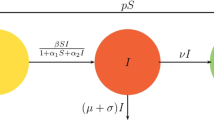Summary
This paper discusses a deterministic model of the spread of an infectious disease in a closed population that was proposed byKermack &McKendrick (1927). The mathematical assumptions on which the model is based are listed and criticized. The ‘threshold theorem’ according to which an epidemic develops if, and only if, the initial population density exceeds a certain value determined by the parameters of the model, is discussed. It is shown that the theorem is not true. A weaker result is stated and proved.
A new simplified version of the model is discussed. In this model it is assumed that an infected individual becomes infectious after a constant time and that it will removed after a constant time. Numerical simulations of this model show that the form of the fluctuations in the number of diseased individuals depends on the values of the parameters. The number of infectious individuals may oscillate up and down under certain circumstances. Necessary conditions for the number of infectious individuals to rise above previous levels are stated and proved.
Similar content being viewed by others
References
The American Public Health Association (1955). Control of Communicable Diseases in Man. 8th ed. New York N.Y. 219 pp.
Bailey, N. T. J. (1957). The Mathematical Theory of Epidemics. Charles Griffin, London, vii + 194 pp
Downton, F. (1967). A Note on the Ultimate Size of a General Stochastic Epidemic. Biometrika54, 314–316.
El'sgol'ts, L. E. (1966). Introduction to the Theory of Differential Equations with Deviating Arguments. Transl. byRobert J. McLaughlin. Holden-Day Inc. San Francisco-London-Amsterdam, ii + 109 pp.
Kendall, D. G. (1956). Deterministic and Stochastic Epidemics in Closed Populalations. Proceedings of the 3rd Berkeley Symposium on Mathematical Statistics and Probability, Vol. IV, p. 149–165.
Kermack, W. O., andA. G. McKendrick (1927). A Contribution to the Mathematical Theory of Epidemics. Proceedings of the Royal Society of London Ser. A. 115, 700–721.
Kermack, W. O., andA. G. McKendrick (1933). Contributions to the Mathematical Theory of Epidemics III, Proceedings of the Royal Society of London, Ser. A.141, p. 94–122.
MacMahon, B., T. F. Pugh andJ. Ipsen (1960). Epidemiologic Methods. Little, Brown and Company, Boston-Toronto, x + 302 pp.
Petrovski, I. G. (1966). Ordinary Differential Equations. Revised English Ed. Transl. and Ed. byR. A. Silverman Prentice-Hall, Inc. Englewood Cliffs, N.J., x + 232 pp.
Simmons, G. F. (1963). Introduction to Topology and Modern Analysis. McGraw-Hill, New York-San Francisco-Toronto-London, xv + 372 PP.
Author information
Authors and Affiliations
Additional information
This investigation was done when the author was a postdoctoral fellow in the Biomathematics Program of the Institute of Statistics at North Carolina State University at Raleigh, N.C., U.S.A. The author's stay in the U.S.A. was made possible by a grant from the Netherlands Organisation for the Advancement of Pure Research (Z.W.O.) and this investigation was supported in part by funds from National Science Foundation Science Development Award GU-1590.
I thank Dr.H. R. van der Vaart, who suggested this investigation, for his stimulating interest, and Mr.J. Lee Murphy for writing and running the computer program.
I also thank Mr.L. Hoekstra for preparing the figures and Mrs.H. Lochorn-Hulsebos for typing the manuscript.
Rights and permissions
About this article
Cite this article
Reddingius, J. Notes on the mathematical theory of epidemics. Acta Biotheor 20, 125–157 (1971). https://doi.org/10.1007/BF01556687
Received:
Issue Date:
DOI: https://doi.org/10.1007/BF01556687




